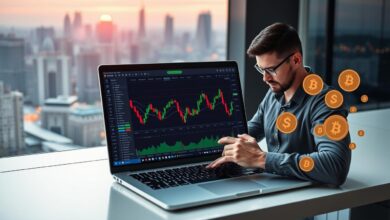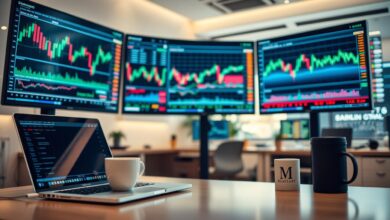Best Futures Trading Platform: Top Picks for Traders
Are you looking to start futures trading? You’ve come to the right place! This guide will show you the best futures trading platforms for all traders. Whether you’re a pro or just starting, you’ll find the perfect platform for you.
Futuristic trading interface showcasing charts and graphs, dynamic data visualization, sleek design elements, glowing interfaces with interactive features, a digital landscape symbolizing market trends, vibrant colors blending technology and finance, illustrating the concept of a leading trading platform.
Futures trading is exciting but can be complex. Not all brokerages offer futures trading. It’s important to find a platform that supports futures and gives you the tools to succeed. In this guide, we’ll explore the top futures trading platforms. We’ll look at their features, prices, and who they’re best for.
Introduction
Futures trading is exciting and dynamic, letting traders make money from price changes in different things. It’s about making deals to buy or sell something at a set price later. This way, traders can guess market trends and make profits while controlling their risks.
Exploring the Importance of Futures Trading
Futures trading is key in the financial world. It helps people and businesses protect themselves from price changes. By setting future prices, traders can manage risks and keep their finances stable. It also makes markets more efficient by finding fair prices for things.
Choosing the Right Futures Trading Platform
The platform you choose affects your trading a lot. It should have tools and features that help your strategy and risk control. Look for a platform with an easy-to-use interface, fast order execution, good market data, learning resources, and fair fees.
A futuristic trading platform interface showcasing dynamic charts, candlestick patterns, and high-tech graphics, with a sleek and modern design, vibrant colors reflecting market trends, and digital elements emphasizing real-time data analysis, portraying an advanced user experience in the financial trading world.
Knowing the value of futures trading and picking the right platform is crucial. It helps traders succeed in this fast-paced and profitable market. Whether you’re new or experienced, the right platform can help you reach your trading goals.
Interactive Brokers – Best for Professional Futures Traders
Interactive Brokers (IBKR) is the top pick for pro futures traders. It gives access to more markets than any other broker. Its trading tech is top-notch, with features like backtesting and automated trading tools.
Key Features and Advantages
IBKR’s platform meets the needs of pro futures traders. The Trader Workstation (TWS) is for advanced traders, offering global market access. The IBKR Mobile platform lets traders use advanced tools on the move.
For a simpler experience, IBKR’s GlobalTrader is great for beginners. It allows small investments and trading in fractions. The IBKR ForecastTrader is for newbies, focusing on economic data and climate events.
Pricing and Commission Structure
IBKR’s interactive brokers futures trading costs range from $0.25 to $2.50 per contract. Discounts apply for more trading. It’s best for big traders due to higher margin needs. IBKR’s futures commissions are low, perfect for those who trade a lot.
| Trading Volume | Commission per Contract |
| 0 – 499 contracts | $2.50 |
| 500 – 999 contracts | $1.50 |
| 1,000 – 1,999 contracts | $1.00 |
| 2,000+ contracts | $0.25 |
“Best futures trading platform, dynamic digital trading interface, professional trader analyzing market charts, multiple screens displaying futures data and graphs, sleek modern office environment, high-tech equipment, focused expression, warm lighting, vibrant color palette”
NinjaTrader – Best for Dedicated Futures Traders
NinjaTrader is our top choice for the best futures trading platform. It offers low-cost pricing, with commissions starting at $0.09 for micro futures and $0.59 for standard ones. The platform has desktop, web, and mobile versions, all with great charting tools. Traders can make trades right from the charts.
NinjaTrader has very low margin rates, needing only $50 for equity index E-mini futures. This is great for traders who need a lot of leverage. The platform also has live streams for market updates, analysis, and trading tips.
The pricing of NinjaTrader fits different traders’ needs. You can choose from a $0 monthly fee, a $99 plan, or a one-time $1,499 payment. There’s no minimum account balance, so it’s open to all traders.
In summary, NinjaTrader is the top platform for active traders. It offers low commissions, aggressive margin rates, and a wide range of trading tools. These features help traders succeed in the ninjatrader futures trading market.
Tastytrade – Best for Casual Futures Traders
Tastytrade is a top pick for casual futures traders. It has a user-friendly interface and a wide range of tools. These make it easy for beginners to explore the futures market. Plus, its pricing is great, with just $1.25 per futures contract and $0.50 per options contract.
The platform is quick and has advanced charting. This is perfect for traders who focus on charts. Tastytrade is also the best futures trading platform for beginners. It offers:
- Intuitive desktop and web-based trading platforms
- Comprehensive market data and analysis tools
- Educational resources to help traders develop their skills
- Tastytrade futures commissions starting at $1.25 per contract
Whether you’re experienced or new to tastytrade futures trading, Tastytrade is a great choice. It has a user-friendly interface, powerful tools, and competitive pricing. This makes it ideal for casual futures traders.
TradeStation – Best for Desktop Futures Trading
TradeStation is the top pick for traders who love a strong desktop platform. It has lots of advanced features and tools for serious traders.
Powerful Desktop Platform and Versatile Features
TradeStation’s desktop platform makes trading smooth and efficient. It comes with many advanced features, including:
- RadarScreen®, a tool for real-time monitoring of up to 1,000 symbols.
- OptionStation® Pro, for building and analyzing options chains and graphs.
- Over 180 customizable indicators in RadarScreen®.
- Decades of historical data for backtesting strategies.
The mobile app lets traders stay connected and trade from anywhere. The desktop platform makes it easy to place orders and manage accounts.
Award-Winning Platform with Competitive Pricing
TradeStation is known for its excellence, winning awards from experts and publications. It has great pricing, with low margin rates on some futures. Plus, it offers $0 commissions on certain futures and low per-contract rates.
TradeStation is perfect for serious futures traders. It has strong desktop features, advanced tools, and good prices.
E*TRADE – Best for Futures Education
E*TRADE is a top choice for futures traders wanting to learn more. It offers a lot of educational resources and tools for trading futures. This makes E*TRADE the best option for those new to futures trading.
Educational Resources and Content
E*TRADE is serious about teaching futures trading. It has many training materials and content. Traders can find articles, tutorials, and webinars to learn about futures trading and managing risks.
The demo account at E*TRADE is a big plus. It lets traders practice without using real money. This way, they can improve their skills and try out different trading methods before trading for real.
Platform Capabilities and Commissions
E*TRADE’s trading platform is full-featured, working on desktop, web, and mobile. Traders can get real-time quotes, make trades, and keep an eye on their positions anywhere. The platform’s fees are also good, with a $1.50 per contract charge plus extra fees.
For staying updated, E*TRADE has a Futures Research Center. Here, traders can find analysis, trading ideas, and quotes to help with their decisions.
E*TRADE is great for both new and experienced futures traders. It has lots of educational resources, advanced trading tools, and low fees. This makes it a top pick for learning and growing in futures trading.
Best Futures Trading Platform: Criteria for Evaluation
Choosing the right futures trading platform is crucial for success. You need to look at the user experience, trading tools, pricing, and educational resources. These factors ensure a smooth and profitable trading journey.
User Experience and Trading Tools
A good platform should be easy to use. It should have powerful charting tools, advanced orders, and customizable layouts. This makes trading more efficient. Traders like platforms that are easy to navigate and offer many analytical tools.
Pricing and Commission Structure
Low fees and competitive margins are key to making money. Look at the broker’s pricing, including execution fees and contract charges. Clear and fair pricing is important for traders.
Research and Educational Resources
Having access to market research and tutorials is essential. Platforms with detailed reports, real-time data, and learning materials are valuable. They help traders improve their skills and make better decisions.
By focusing on these criteria, traders can find the best platform for them. This choice can greatly improve their success in futures markets.
Top Platforms Compared: Features and Pricing
Choosing the right futures trading platform is key for traders in the fast-paced futures market. We’ve compared the top futures brokers like Interactive Brokers, NinjaTrader, Tastytrade, TradeStation, and E*TRADE. This review looks at important features, trading options, and fees to help you pick the best platform for your trading style.
| Feature | Interactive Brokers | NinjaTrader | Tastytrade | TradeStation | E*TRADE |
| Desktop Trading | ✓ | ✓ | ✓ | ✓ | ✓ |
| Web-based Trading | ✓ | ✓ | ✓ | ✓ | ✓ |
| Mobile Trading | ✓ | ✓ | ✓ | ✓ | ✓ |
| Paper Trading | ✓ | ✓ | ✓ | ✓ | ✓ |
| Trading Tools | Advanced | Comprehensive | User-friendly | Robust | Extensive |
| Futures Commissions (Open/Close) | $0.85 / $0.85 | $1.25 / $1.25 | $1.50 / $1.50 | $1.50 / $1.50 | $1.50 / $1.50 |
| Options on Futures Commissions (Open/Close) | $0.85 / $0.85 | $1.25 / $1.25 | $1.50 / $1.50 | $1.50 / $1.50 | $1.50 / $1.50 |
By looking at the features and costs of these top futures trading platforms, you can choose wisely. Whether you’re a pro trader, a futures expert, or just starting, this detailed comparison will guide you to the right platform.
Getting Started with Futures Trading
If you want to start futures trading, the first thing to do is open a brokerage account. The good news is that you only need less than $1,000 for most online brokerages. This makes it easy for both new and experienced traders to get started.
Understanding margin and leverage is key in futures trading. You can control big positions with a small amount of money. This is because of margin, which is a small part of the contract’s value, usually 5-10%.
Margin lets you make more money, but it also means you can lose more. It’s important to manage your risk well. Knowing how to handle leverage is crucial for success in futures trading.
Minimum Account Requirements
- Most online brokerages require less than $1,000 to open a futures trading account.
- The low minimum account requirement makes futures trading accessible to both novice and experienced traders.
- Ensure you have sufficient capital to meet the initial margin requirements and manage your risk effectively.
Understanding Margin and Leverage
- Margin is the amount of capital you need to put up to open a futures contract, typically around 5-10% of the contract’s full value.
- Leverage allows you to control a large position with a relatively small initial investment, amplifying both your potential profits and losses.
- Proper risk management is crucial when trading with leverage to avoid significant losses beyond your initial margin.
By knowing the minimum account requirements and how margin and leverage work, you’re ready to start in futures trading. Always remember to manage your risk and have a solid trading plan. This will help you succeed in this exciting market.
Risk Management Strategies for Futures Traders
Futures trading is risky because of the high leverage. It’s key to manage risk well for success. Strategies include setting stop-loss orders, diversifying, and using position sizing.
Having a clear trading plan is vital. It’s also important to keep an eye on market changes and adjust your trades. Experts say to risk no more than 1% to 2% of your capital on one trade.
- Successful futures traders usually risk only 10% to 20% of their margin. Retail traders often risk too much and lose big.
- Limiting risk to 2% of total equity per trade can lead to long-term success.
- Liquidity risks are high in small commodity futures or niche sectors. Diversifying is crucial.
- Professional traders use leverage wisely to reduce risk. They keep positions small, ideally below 2% of capital.
Setting stop-loss orders is a smart move for traders. It’s important to understand potential losses by looking at historical price movements. Emotional trading decisions are risky, so it’s best to follow a systematic plan.
Diversifying across markets and strategies helps reduce risk. Options on futures offer tools like hedging and strategic flexibility.
Learning risk management techniques can lower overall risk in futures trading. Traders must accept losing money as part of the business. Only taking the best trade setups can help avoid capital loss.
Best Practices for Successful Futures Trading
To be a successful futures trader, you need a solid trading plan. This plan should cover your investment goals, how much risk you can take, and your trading strategies. It should have clear rules for when to start and stop trades, along with risk management steps like setting stop-loss orders. It’s vital to manage risk well because futures trading can lead to big wins or losses.
By having a good trading plan and sticking to it, you can do well in the futures market.
Developing a Trading Plan
A good futures trading plan should have a few key parts:
- Clear goals and how much risk you’re okay with
- Plans for when to enter and exit trades, based on analysis
- Rules for how much to invest in each trade
- Plans for unexpected market changes or personal issues
Importance of Risk Management
Risk management is crucial in futures trading because of the high leverage. Using strategies like stop-loss orders, spreading your investments, and keeping an eye on your trades can help. These steps can help you deal with the market’s ups and downs and keep your money safe.
| Risk Management Strategies | Benefits |
| Position Sizing | Limits the amount of capital at risk per trade |
| Stop-Loss Orders | Automatically closes positions at pre-determined levels to limit losses |
| Diversification | Reduces the impact of losses in any single market or position |
By having a detailed trading plan and managing risk well, you can handle the futures market’s challenges. This can help you succeed in the long run.
Conclusion
We’ve looked at the top futures trading platforms for all traders. Whether you’re a pro or just starting, there’s a platform for you. Interactive Brokers, NinjaTrader, Tastytrade, TradeStation, and E*TRADE offer what you need.
Think about what you want to achieve in trading. Consider your risk level and how you like to trade. Choose a platform that fits your needs and helps you succeed.
The futures trading world is always changing. Platforms like E-Futures International have been around for over 30 years. They offer easy-to-use interfaces, real-time data, and quick customer support. These features help traders make smart choices and reach their goals.
FAQ
What is the best futures trading platform for professional traders?
Interactive Brokers (IBKR) is our top choice for professional futures traders. It offers more markets than any other broker. Its technology is top-notch, with tools for backtesting and automated trading.
IBKR also has low commissions for high-volume traders.
Which platform is best for dedicated futures traders?
NinjaTrader is our top pick for dedicated futures traders. It has low-cost pricing, with commissions starting at $0.09 for micro futures. NinjaTrader also has desktop, web, and mobile platforms with great charting.
What is the best futures trading platform for casual traders?
Tastytrade is our top choice for casual futures traders. It has a user-friendly interface and tools for beginners. Tastytrade’s pricing is also good, with $1.25 per futures contract.
Which platform is best for desktop futures traders?
TradeStation is our top pick for desktop futures traders. It has a robust desktop interface with great tools for charting and analysis. TradeStation also lets you backtest strategies and create automated algorithms.
What is the best futures trading platform for educational resources?
E*TRADE is our top choice for futures education. It offers a lot of content and training to help investors learn. This includes articles, tutorials, and a demo account for practice.
What are the key criteria to consider when evaluating the best futures trading platforms?
We looked at several key criteria when choosing the best futures trading platforms. These include user experience, trading tools, pricing, and educational resources. A good platform should have a user-friendly interface and advanced tools.
Low commissions and competitive margin requirements can also help increase profits. Access to market research and tutorials is important for all traders.
How do I get started with futures trading?
To start futures trading, open a brokerage account and meet the minimum requirements, usually under $1,000. Understand margin and leverage, as they can affect your profits and losses.
What are some key risk management strategies for futures traders?
Risk management is key for futures traders. Use stop-loss orders, diversify your portfolio, and size your positions carefully. Having a trading plan and monitoring the market are also crucial.
What are the best practices for becoming a successful futures trader?
To succeed in futures trading, create a detailed trading plan. It should outline your goals, risk tolerance, and strategies. Include entry and exit criteria and risk management techniques like stop-loss orders.
Stick to your plan and adjust as needed. High leverage in futures trading can greatly impact your results.





